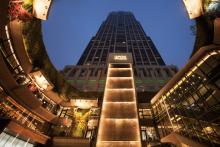29 Jun 1942, Chronology of Events Related to Stanley Civilian Internment Camp
Primary tabs
A hot, clear day, and one of huge emotion.
The Asama Maru, the ship which will take most of the Americans on the first stage of their journey home under a US-Japanese repatriation agreement, sails up the Lamma Channel and anchors about three miles off the Lamma Island Point.
The Americans in town - mostly bankers and consular staff - are coming to Stanley by road, those in the camp have said their last goodbyes and are confined to their quarters. At 2.30 or a little after they submit to a last luggage inspection, and then they'e marched off to small launches that are to take them to the Asama Maru:
At length the ferry moves away from the dock, across the choppy water of the bay and draws up by the lofty white side of the Asama. We peer upward and see see the faces of Americans looking down at us. These are men and women brought from Tokyo and Korea.
Most of the remaining internees are watching. Journalist Gwen Dew was one of those leaving:
Finally everyone was taken from the shore, and the boat turned slowly to the ship which awaited us at sea. We stood by the railing, waving goodby to those we could not see through the tears. Those high hills of camp were black wth people, for almost the entire 3,000 British and Dutch, and a few Americans who were left behind, were standing there, bravely watching, waiting and weeping.
Norman Briggs is also leaving:
The British were all lined up to bid us farewell. I never have seen, I never want to see, and I never expect to see a sadder or more depressing sight than that departure from Stanley.
Briggs is angry with those Americans not doing all they can to help the British.
I wonder how those Americans felt who were taking food and money with them? I did not have that on my conscience.
Before they board there’s one last hurdle: an inspection by a consular official, an internee representative and a Japanese officer.
Finally, they’re aboard. But any hopes of a quick escape are soon dashed. The ship’s still there at the end of the day. There is an international agreement by which exchange ships keep their lights on at night to make sure they can be identified by war planes, but the Japanese military authorities demand that the Asama Maru go dark tonight as they fear lights will be used to guide American bombers. This seems to be the only night on which the rule was breached - unnecessarily as the American bombers won't arrive until October 25.
Back in town, Thomas Edgar marries Evelina Marques d’Oliveira at about the time the Americans were getting into the ferries. Owen Evans is the best man. The couple will live on the compound of the French Hospital.
Sources:
Gwen Dew, Prisoner of the Japs, 1943, 151
Carol Briggs Waite, Taken in Hong Kong, Kindle Edition, Location 3156
Wenzell Brown, Hong Kong Aftermath, 1943, 278
Lights: David Miller, Mercy Ships, 2008, 104, 183
http://brianedgar.wordpress.com/2011/11/05/a-wartime-romance/

